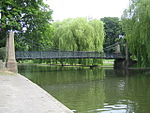Lealands High School
Lealands High School, formerly Sundon Park Comprehensive School, is a foundation school for 11 to 16 year olds located in Sundon Park, Luton. The school attracts students from Sundon Park and across Luton and Bedfordshire. It was judged good with outstanding behaviour and safety by Ofsted in 2013 and confirmed to continue being a good school overall in March 2017 following a short inspection by Ofsted. In 2014 the school was placed in the top 100 most improved secondary schools for GCSE results including English and maths over a sustained period. Main feeder schools include Sundon Park Juniors School, Leagrave Primary and Pirton Hill, although students join Lealands from primary schools across Luton and the surrounding areas.
Excerpt from the Wikipedia article Lealands High School (License: CC BY-SA 3.0, Authors).Lealands High School
Sundon Park Road,
Geographical coordinates (GPS) Address Phone number Website Nearby Places Show on map
Geographical coordinates (GPS)
| Latitude | Longitude |
|---|---|
| N 51.918 ° | E -0.47 ° |
Address
Lealands High School
Sundon Park Road
LU3 3AL , Sundon Park
England, United Kingdom
Open on Google Maps










